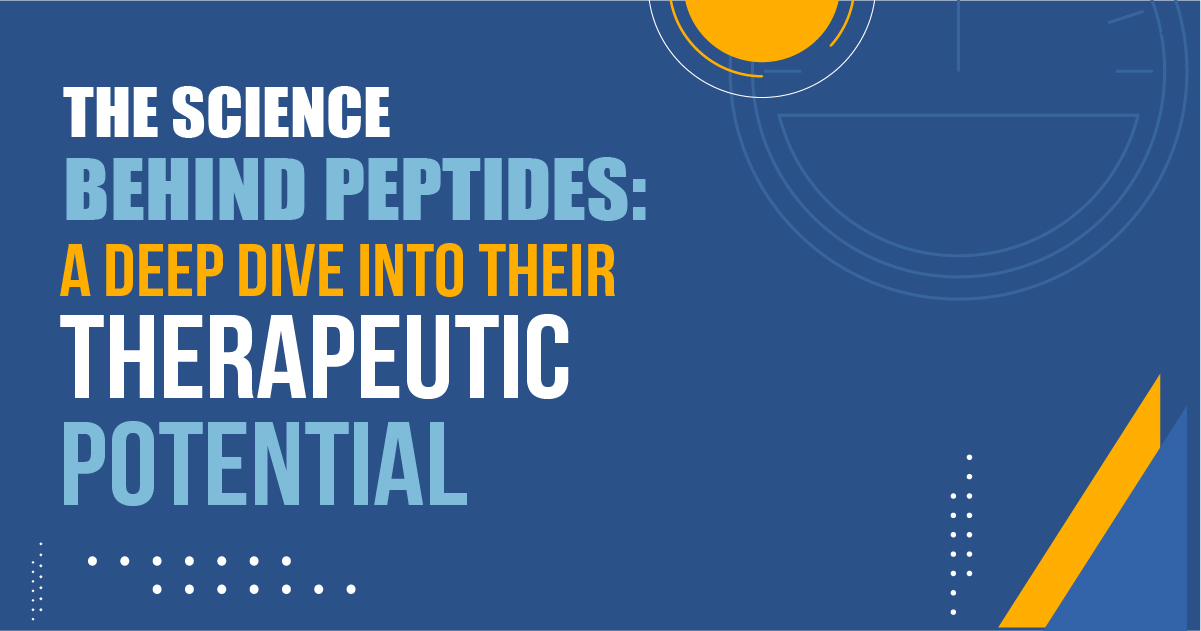The Science Behind Peptides: A Deep Dive into Their Therapeutic Potential

Not many compounds have generated the same thrill as peptides. Originally limited to minor scientific publications, some of the most innovative therapies in cancer, endocrinology, dermatology, and other fields now center around little chains of amino acids. But just precisely what are peptides? Their method is how? And why are they seen as the direction of targeted treatments going forward?
Let’s dissect the science behind peptides and investigate why they are fast-rising to be the main players in contemporary medicine.
What Are Peptides?
Fundamentally, peptides are short sequences of amino acids usually between 2 and 50 connected by peptide bonds. See them as the younger siblings of proteins. Although proteins may be big, sophisticated molecules folding into complicated forms, peptides are smaller, more agile, and often rather precise in their biological purposes.
Many peptides operate as signaling molecules, hormones, enzymes, or antimicrobial agents; unlike proteins that could need complex folding to function, many peptides have linear shapes. In drug design, their simplicity and precision provide a clear advantage.
Nature’s Messengers: How Peptides Function in the Body
Peptides are already vital workers within your body; they are not manufactured creations. From controlling blood sugar levels (insulin) to helping sleep cycles (melatonin) and sending messages in the brain (endorphins), peptides act as biological messengers organizing many physiological events.
These are some noteworthy examples:
- Hormonal Peptides: Like glucagon and oxytocin, which control metabolism and emotional bonding, hormonal peptides control also metabolic rate.
- Neuropeptides: Substance P, related to pain sensation.
- Antimicrobial Peptides: Defensins and cathelicidins assist the body fight against infections using antimicrobial peptides.
These natural functions make peptides perfect targets for therapy development. Under careful engineering, synthetic peptides may precisely replicate or improve these effects.
The Value of Precision: Why Ideal Therapeutic Agents Are Peptides
Peptides in medicine are among their most fascinating features and their target selectivity. Unlike many small-molecule medications that could impact many systems—sometimes resulting in undesired side effects—peptides can be specifically matched to bind with laser-like precision to a particular receptor or pathway.
This implies:
- Fewer off-target consequences
- Reduced mandated doses
- Enhanced safety records
- Capacity to deliberately breach biological boundaries
Tumor-targeting peptides are being employed, for instance, in cancer treatment to deliver medications straight to malignant cells while preserving good tissue. In metabolic diseases, peptides such as GLP-1 analogs assist in controlling glucose levels without causing the hypoglycemic effect.
Therapeutic Uses: Where Peptides Are Changing Things
Already changing patient outcomes in numerous important spheres are peptides:
- Cancer
- Cytotoxic medications are being delivered straight to malignant cells using cancer tumor-homing peptides, therefore improving therapeutic efficacy and reducing collateral harm.
- Metabolic Diseases
- Originally developed as a family of peptide-based medications, GLP-1 receptor agonists have transformed the management of Type 2 diabetes and are now under investigation for their cardiovascular effects.
- Skin Condition and Anti-Aging
- Popular in dermatological treatments and skincare, peptides such as Matrixyl and Argireline boost collagen formation and help to lessen the look of wrinkles.
- Neurology
- Aiming to shield neurons from injury or stimulate regeneration, research on neuroprotective peptides for disorders including Alzheimer’s and Parkinson’s illnesses is never-ending.
- Infectious Illnesses
- Developed to fight resistant forms of bacteria and viruses, antiviral and antibacterial peptides provide a fresh weapon against developing worldwide health hazards.
Behind the Scenes: Peptides’ Synthesis
Mostly produced using Solid-Phase Peptide Synthesis (SPPS), a 1960s method designed for exact assembly of amino acid sequences,
Here’s a condensed analysis:
- The amino acid choice depends on the intended therapeutic impact.
- Attaching a solid resin will help you to create the chain from one end.
- Every amino acid is added one step at a time inside protecting groups that guarantee the right sequence.
- The resultant peptide is extracted from the resin and purified by methods like HPLC (High-Performance Liquid Chromatography).
The outcome is: a pure, very specific molecule appropriate for either preclinical or clinical investigation.
Peptide Therapeutics: Challenges and Novelties
Despite their potential, peptide-based medications have a few challenges:
- Short half-life in the circulation brought on by enzymatic degradation
- Restricted oral bioavailability; most peptides need to be injected or given another way
- Synthesis and purification in production may be costly
Nevertheless, science is catching up. Advances in oral formulations, nanoparticle delivery methods, and peptide stabilization are stretching limits. Shelf life and biological performance are extending modified peptides including cyclic peptides and peptidomimetics.
Where Are We Headed The Future of Peptides?
Peptides are likely to be very important as customized therapy develops. Precision treatments find them perfect as they may be tailored for specific people or disease paths.
Among the new trends are:
- Peptide vaccinations aiming against cancer and viruses
- Systems of gene delivery based on peptides
- Peptide-drug conjugates that combine in one molecule target and therapeutic potency
The future is closer than you would imagine peptide-shaped.
In Summary
While tiny molecules have great potential, their effects on medicine are somewhat different. From replicating natural hormones to focusing on the most mysterious illnesses, these flexible molecules are bringing in a new age of safer, smarter, and more successful medicines.
Research progress provides almost endless opportunities. Peptides represent a movement rather than just molecules. And that’s something to be enthusiastic about for patients, doctors, and scholars equally.
